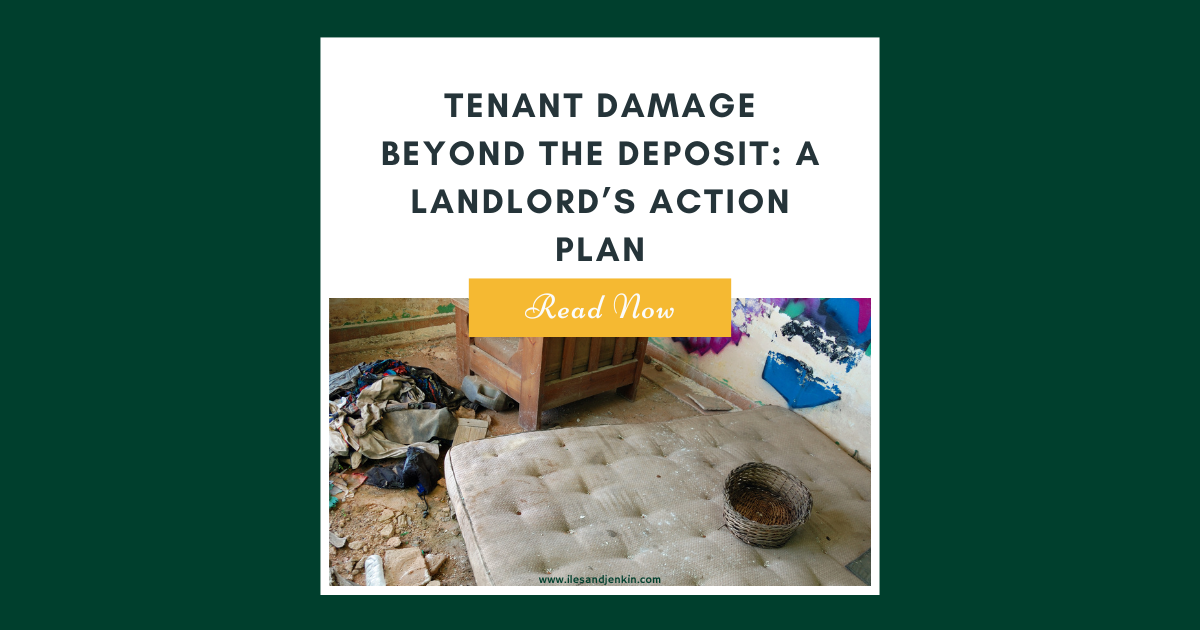Tenant Damage Beyond the Deposit: A Landlord’s Action Plan
As a landlord, one of your responsibilities is to manage the risk of damage caused by tenants. While a tenancy deposit is designed to cover the cost of minor damage or cleaning at the end of a tenancy, sometimes the damage goes beyond what the deposit will cover. When that happens, it’s important to know what your next steps are - both legally and practically - to recover costs, protect your investment, and remain compliant.
1. Preventive steps during the tenancy
Before damage escalates, your best defence is proactive management. Here are key actions you should take:
Regular inspections/visits: Conduct mid-tenancy property visits (e.g., every 3-6 months) to check the condition of the property, spot early signs of damage (such as damp, mould, misuse of appliances, unauthorised pets) and address issues promptly. Document these inspections with dated reports and photographs.
Detailed inventory & check-in/out reports: At the start (and ideally at the end) of each tenancy you should have a detailed inventory with photographic evidence of the condition of the property, fixtures and fittings, upholstery, and any existing wear and tear. At move-out, compare carefully against the inventory.
Good tenancy management and communication: Make sure tenants know their obligations, encourage them to report issues promptly, and respond swiftly to concerns. Early intervention can stop a small issue becoming a major repair cost.
Use of standard clauses and documented communication: Ensure your tenancy agreement clearly states expectations around care of the property, responsibility for damage beyond fair wear and tear, and landlord’s rights of access. Keep all communications in writing (email or portal) so you have a record.
Maintain the property properly: Even if the damage is tenant-caused, landlords must ensure the property remains compliant with statutory safety and maintenance obligations (e.g., gas, electrical, fire safety). By showing you have maintained the property to the correct standard, you strengthen your position when claiming for tenant damage.
If you have taken those steps, you are in a strong position to move to next stage if damage exceeds the deposit.
2. When damage exceeds the deposit - recovery options
When the cost of damage goes beyond what the deposit covers, you have a few options:
Use the deposit first: After the tenancy ends, you can deduct from the deposit for damage, cleaning, unpaid rent, etc., following the scheme rules if it’s a protected deposit.
Negotiate with the tenant or guarantor: Often it’s worth contacting the tenant (or guarantor) in writing to say: “the deposit has been used/insufficient for this damage, we require a further payment of £X by date Y.” Provide evidence (photographs, invoices, schedule of works).
Consider a small claims court action: If the tenant (or guarantor) refuses to pay the additional amount, and you have clear evidence, you may make a claim in the County Court via the small claims procedure to recover the balance. According to guidance, landlords can file a claim for damage caused to property (beyond normal wear and tear).
3. Using the small claims court - process, cost & timescales
Here’s a breakdown of how the small claims route works, what it costs and what to expect:
What is a small claim?
In England & Wales, many landlord claims for damage or unpaid rent fall under the small claims track. Generally, if the amount is up to £10,000 it may be treated as a small claim. GOV.UK+1 Note: Some specialist matters (e.g., severe disrepair over £1,000) may require a different track.
Pre-action steps
You should carry out pre-action steps before issuing a court claim: send a “letter before claim” (sometimes called pre-action protocol letter) giving the tenant/guarantor a reasonable period (often 14 days) to respond. Provide full details of the damage, the cost, and your intention to issue a claim if no payment is made. Without this step, the court may penalise you.
Claim form and submission
You can submit a claim online using the portal (Money Claims Online) or by post. You must include your details, the tenant’s details (or guarantor’s), the claim amount, and the particulars of your claim (what you are claiming and why). You will need the evidence prepared: inventory, inspection records, photographs, contractor’s invoice, quotes, proof of ongoing tenancy manager/agent involvement. GOV.UK+1
Court fees
The court fee depends on the value of the claim. For example:
Up to £300: £35
£300.01 to £500: £50
£500.01 to £1,000: £70
£1,500.01 to £3,000: £115
£3,000.01 to £5,000: £205 GOV.UK+1
Do note that even if you win, you may still incur other costs (your time, possible legal advice, enforcement if the tenant doesn’t pay). The small claims track is designed so each side usually bears their own legal costs.
Timescales
There is no fixed time for resolution, but typical small claims cases (if straightforward) may move from submission to judgment in weeks to a few months depending on court workload, complexity, whether the claim is defended, whether mediation is required. For civil applications, the government target is 20 working days for many cases. GOV.UK
Enforcement
If you win a judgment and the tenant/guarantor doesn’t pay, you may need to apply for enforcement (e.g., warrant of control, attachment of earnings, third-party debt order). That process has its own cost and time implications.
4. Evidence: What you must have to succeed
For a strong case you will want:
The tenancy agreement and any guarantor agreement.
Inventory and check-in report with photographs showing condition at start, move-in, and ideally at move-out.
Records of inspections or visits during the tenancy (date, what was found, photos).
Photographic/video evidence clearly showing the damage beyond fair wear and tear (with date/time stamps).
Invoices/quotes from contractors for the repair/replacement work, showing cost.
Email or written communications with tenant regarding damage, any warnings given, attempts to repair, reminders sent.
Proof you attempted negotiation or settlement before issuing claim (e.g., letter before claim).
Without good evidence, your claim is less likely to succeed and may be dismissed.
5. Practical tips for landlords
Set aside budget for “damage beyond fair wear and tear” – even good tenants may occasionally cause higher-level damage.
Ensure your inventory and check-in/out process is robust and uses clear photos/videos.
Label clearly what is “normal wear and tear” vs what you define as tenant damage. e.g., carpet wear is likely acceptable; large burn marks or vandalism are not.
Keep a clear maintenance log / inspection schedule - this also shows your diligence as landlord/agent, strengthening your position.
Use a professional property management partner (or dedicated software) to help document, manage quotes/invoices and stay on top of risk.
Don’t automatically assume the deposit will cover everything - if the damage is significantly beyond, act early rather than waiting.
Consider including a guarantor in the tenancy if you accept higher risk tenants, making recovery of additional costs easier.
Before going to court, weigh up the cost vs benefit - if the cost of the claim (your time + court fee + potential enforcement) is nearly equal to the claim amount, you may decide to settle or simply absorb the loss. Citizens Advice
6. Summary & next steps
Damage beyond the deposit is a scenario no landlord wants, but with good processes and timely action you can protect your investment. Start with prevention: inspections, robust inventory and clear documentation. If damage occurs, negotiate and then, if needed, make use of the small claims court to recover costs provided you have solid evidence.
By taking early, structured action you send a message to tenants, maintain higher property standards, protect your asset value and promote compliance. And in a professional, regulated environment (especially with the pending reforms in the UK rental sector) being proactive and diligent will stand you in good stead.
If you’d like help setting up your inspection schedule, improving your inventory process, or understanding how the small claims route works in more detail, we at Iles & Jenkin would be happy to assist.
Useful links
Make a court claim for money (HM Courts & Tribunals Service) – https://www.gov.uk/make-court-claim-for-money/what-you-need-to-do GOV.UK
Court fees for money claims – https://www.gov.uk/make-court-claim-for-money/court-fees GOV.UK
Claim for damage/unpaid rent (MoneyClaimsUK) – https://www.moneyclaimsuk.co.uk/helping-people-like-you/how-do-I-make-a-claim-for-tenant-damage.aspx moneyclaimsuk.co.uk
Deciding whether to make a small claim (Citizens Advice) – https://www.citizensadvice.org.uk/law-and-courts/legal-system/small-claims/deciding-whether-to-make-a-small-claim/ Citizens Advice



 By
By 
 posted by
posted by 


Share this with
Email
Facebook
Messenger
Twitter
Pinterest
LinkedIn
Copy this link